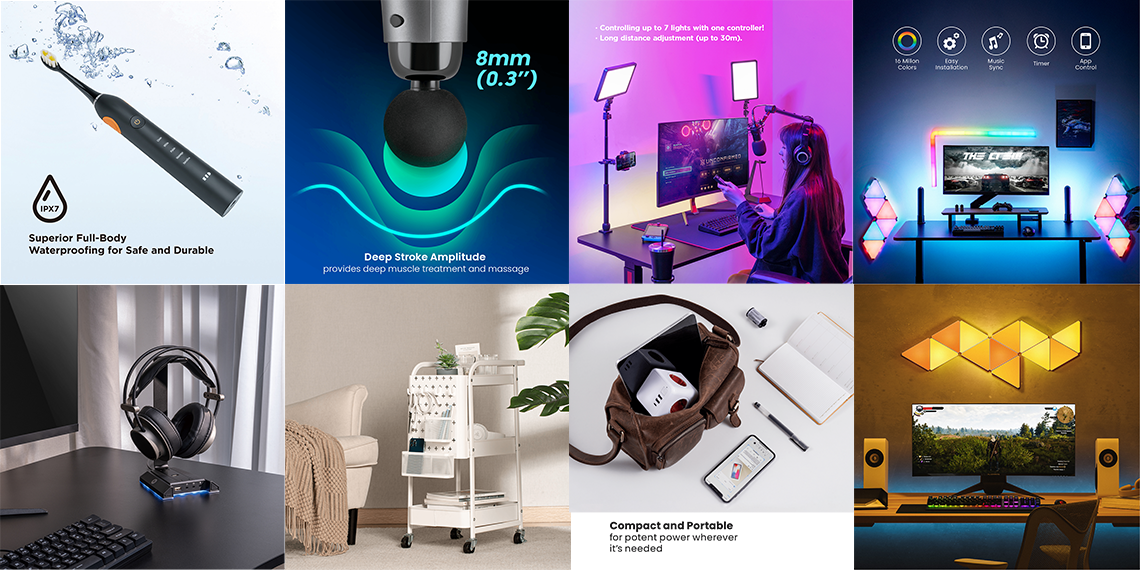Amazon Product Listing Optimization:
Makes the Unseen Seen
February 29, 2024

1. Introduction
“Why do my products barely get attention?” “What have my competitors done to always have high rates of clicks and sales?” These questions must be familiar to you if you are Amazon sellers struggling with your product listings and SEO. Up until 2022, research demonstrates that 1.9 million out of 9.7 million Amazon sellers that are registered on the platform are active. To shock you even more, every minute in the USA, there are over 7,500 products sold on Amazon. Under such surging competitive pressure, effective product listing optimization will literally make or break an Amazon business, for it directly exposes or hides your products in front of the searching engine. In this article, we will go over important components of Amazon SEO, along with best practices for optimizing your product listings to increase sales and boost conversion rates.
2. Amazon Product Listing Optimization at a Glance
The Amazon product listing stands for the product page for each of the items you sell on Amazon. It is composed of information including product title, images, videos, description, price, reviews, and all other relevant, crucial data that tells customers whatever they need to know about the product. Amazon product listing optimization then refers to the process of leveling up your product information page to increase traffic and conversion. Specifically, it involves strategies such as modification of the product title, keyword improvement, image enhancement, and video adjustment. Once your product listings are optimized, the search engine finds it simpler to understand listings and present shoppers with suitable products. With product visibility raised, the customer experience and chances of connecting with more customers are positively influenced, contributing to increased sales and better brand
3. Amazon Ranking Algorithm
Now you must be so eager to start your own product listing optimization after hearing its loads of benefits. First things first, before we put our hands on optimizing the listing pages, we need to find out how Amazon ranks SKUs in search results.
The A9 algorithm is the name of a search engine algorithm that Amazon develops to power its product searches. Conceptually, it represents a method of searching that finds you some of the greatest options for products by swiftly reading and analyzing all the information available on the market. Products that have relevant matches for a customer's inquiry are ranked highest on the results page by this AI-based system. In other words, relevance is one of the principles it adheres to: in order to rank higher, one must ensure that their listings are highly relevant to consumers' searches and optimize them for search engines. Moreover, the system picks up on past search trends and adjusts to show users the relevant results. The powerful characteristics of the A9 algorithm make it one of the most considered factors when Amazon sellers optimize their product listings for SEO.
4. Crucial Factors that Determine A9 Algorithm
After introducing the potent features of the A9 algorithm, we are now moving on further to examine how it is related to other factors. Like any other search engine, the Amazon A9 algorithm takes into account a number of characteristics when rating a product, which would all have significant impacts on your product listing optimization for SEO.

4.1. Keyword Relevance
Above all the potential contributors, keyword relevance stands for the first and foremost piece. Recalling the principle of relevance that is invisibly followed by the A9 algorithm, Amazon only displays a product listing that contains keywords related to the search criteria entered by the customer. For accuracy, it is suggested that you use professional keyword tools to get access to relevant, Amazon-specific content for your product listings. Once the proper keywords are found, you are free to use them to strategically optimize the description, bullet points, title, and backend keywords of your product listing.
4.2. Pricing
Pricing has a non-negligible impact on your product's ranking in the Amazon A9 algorithm, for customers are always looking for the best deals on products—the lower the price, the more likely the customers are willing to purchase. One thing that's tricky is that the more customers purchase, the higher the A9 algorithm will rank the product in Amazon’s search results. However, you certainly cannot set the prices too low—you need to generate enough profits after all. In other words, appropriate pricing is what the A9 algorithm keeps supervising.
4.3. Product Images

In an online economy where consumers are unable to directly interact with the product, images dominate their purchasing decisions. This is not only because it is human nature to prefer visually attractive images, but also because a high-quality image creates a credible depiction of the products in customers’ minds. Therefore, it is not surprising to discover that clear, vibrant, and attractive product images increase conversion rates and appeal to the Amazon A9 algorithm, which eventually raises the ranking of your listing in search results.
4.4. Reviews
Reviews left by customers who have already bought your products are considered another factor that heavily impacts your product rankings. As the online economy connects people regardless of their locations or familiarities, customers nowadays treat reviews as honest suggestions produced by families and friends to evaluate whether the product is worth purchasing. Under this background, the Amazon A9 algorithm not only looks at the number of reviews for each product but also pays attention to the sentiment of the reviews—positive ratings and comments stand for the key factors that win higher rankings for your product listings.
4.5. Product Listing Completeness
To finalize the potential factors, some products are ranked low by the A9 algorithm due to one reason that is frequently omitted—many Amazon sellers tend to just add tidbits of information and publish their product. This defect can be fatal. Imagine a product page without prices, descriptions, or complete titles; then how will this product show up when a buyer searches its relevant data? Less information relevancy would obviously attract fewer click-through rates from customers. That is why we say that providing the audience with all the valuable information is considered necessary for the A9 algorithm to fully expose your products to the search engine.
5. Step by Step Guide to Optimize your Amazon Product Listings
So far, we have learned about the rationales behind Amazon product listings. Now it’s time to prepare for your own product listing optimization.
● STEP 1: Perform Keyword Research
The very first step that initiates your product listing optimization is keyword research. Remember, keywords refer to words and phrases that are used in your product listings to inform customers and the Amazon algorithm that your product is appropriate for a certain Amazon search. Comprehending and effectively utilizing high-volume keywords will facilitate the visibility of your items in natural search results and significantly impact your degree of achievement as an Amazon seller.
While organizing your keywords, it is common to use keyword tools such as Google Keyword Planner. We also recommend that you compile a shorter list of essential goal keywords (often 3 to 5 phrases) that will serve as your starting ranking targets. By doing this, you can make sure that they are highlighted in phrase forms in your product listings, which is crucial for achieving a high position on Amazon's search engine results page. Always pay attention to relevancy, for once the keywords in your product listings develop to be more relevant with higher searching volumes, the wider coverage your listings will tend to have.
● STEP 2: Complete Product Information
1.Compelling Product Title
An eye-catching product title plays an essential role in dragging customers into your stores for purchasing purposes. The basic principle of creating titles begins with addressing user intent—that is, the title of your product should align with the type of customers you are serving. Also, considering that there is a 200-character restriction on Amazon product titles, do not waste space by including superfluous terms. To give you more details, it has been found that Amazon tends to take the first five words of product titles (which make up about 80% of titles on search engine results pages) into account when creating URLs. With a few exceptions—stop words such as "a" and "and"—each word from the title of its corresponding listing is used to serve as this "canonical URL." For this reason, it is important to include potential keywords in your product titles, but use dashes (-) or pipes (|) to break those keywords for readability enhancements.
2.Accurate Product Description
A great product description is considered the key to success while optimizing your product listings. The description part has a direct impact on customers’ purchasing decisions, for it tells the customers what your products are, where they can be used, and how they can make a difference in their day-to-day lives. Hence, you should keep your description concise and precise so that factual information can be easily observed. Instead of using time-sensitive or subjective terms like “hot-selling this year” and “great value," your language must be objective and convincing. To further emphasize your product, remember to include the brand name, model number, and series, even if they are already in the title. Do not forget to highlight crucial characteristics of your products, as they effectively differentiate your products from those of your competitors.
3.Attractive Product Features
Developing attractive product features is another non-negligible step while optimizing your product listings. Usually, product features are listed using Amazon bullet points rather than chunks of text or large paragraphs to simplify customers’ reading experiences. But there is one thing that you need to keep in mind: making too many bullet points is not encouraged. Research shows that the majority of Amazon’s top sellers use no more than five bullet points to highlight their product features. Based on this finding, it is suggested that you list the most important features of your product on the first two points, followed by the less important ones. You should also incorporate call-to-action words in these points to trigger customers’ purchasing behaviors. Again, do check your language objectivity—subject terms cannot fully distinguish your products from other sellers!
● STEP 3: Design Product Images
The importance of E-commerce graphics as an emerging communication tool online has been unparalleled. As sellers, you need to include at least product shots, lifestyle shots, and product infographics for comprehensive visual demonstrations. Explaining this in detail, products should occupy 80% of the space provided to ensure customers’ attention is sufficiently and properly gathered. Close-ups and clear shots of products are also suggested to be uploaded to highlight the focused features of the products. Attractive lifestyle images should be added for the purpose of interpreting products’ applications in different daily scenes.
Generating high-quality images is never an easy task, and it is common for you to be worried about it. But no need to struggle! Treefruit is capable of delivering diversified services to handle your creative needs. You are welcome to try our professional product photography which includes a variety of treatments such as white background images, high-resolution shots, and picture retouching. Our professional equipment and production process stand for the guarantee that you will have images decorated and beautified.

Created by treefruit. Do not use without permission
● STEP 4: Optimize Product A+ Content
Once you have optimized product titles, description words, and focused features, you can take things to the next level by fully utilizing the extra space and branding opportunities that Amazon provides with A+ content. As discussed in our previous blog, an effectively optimized A+ content leads to increased traffic and eventually higher conversion rates. Accordingly, Treefruit offers comprehensive services for product listing pages. For both basic A+ content and premium A+ content, our professional team can provide you with all kinds of customized designs to cater to your unique requirements. All you need to do is tell us what your product is!

Created by treefruit. Do not use without permission
● STEP 5: Manage Product Reviews
1. Ask for Product Reviews
There is a rule set by Amazon that manufacturers and sellers are not allowed to give incentives in exchange for feedback. But that does not mean you cannot ask for more product reviews at all—if customers or anybody who has bought your goods in the last several months without being given any incentives, you are free to ask them if they are willing to share product reviews.
2. Request Removal of Fake Reviews
In the customer feedback section, sometimes you can notice that not all reviews are related to the products. For instance, other issues, including shipping and customer support inquiries, may show up. Such irrelevant reviews should be requested to be removed.
3. Respond to Messages Promptly
Customer reaction time is one of the factors that Amazon's Buy Box algorithm considers when evaluating the top seller. To achieve optimal outcomes, try to reply to all client communications within a day, and preferably sooner!
● STEP 6: Search Terms
The search term section is shown only in the listing’s backend. The rule is also simple while managing this section: enter your primary keywords that are not used for the product title, one per line. Remember to incorporate a couple more secondary search terms, for example, variations of the products, including misspellings, abbreviations, and applications.
6. Watch Out for Forbidden Words
Hang on, now we are so close to completing our product listing optimization! One more rule that is crucial for Amazon sellers to follow is that you must not include forbidden keywords that are banned or restricted owing to policy violations, including trademark infringement, adult content, and prohibited products. Before finalizing your product listing optimization, check Amazon's restricted keyword list and see whether inappropriate words are used. Keeping up with the restricted keyword list is essential for sellers because it might have an impact on the visibility and search ranking of your products on Amazon.
7. Final Thoughts
Product listing optimization is never a one-step task. To ensure high visibility of products, you need to not only develop a comprehensive view of the Amazon ranking algorithm along with the rationales behind it but also apply appropriate and effective procedures to attract customers’ attention. But worrying too much is unnecessary—you will learn by doing!

